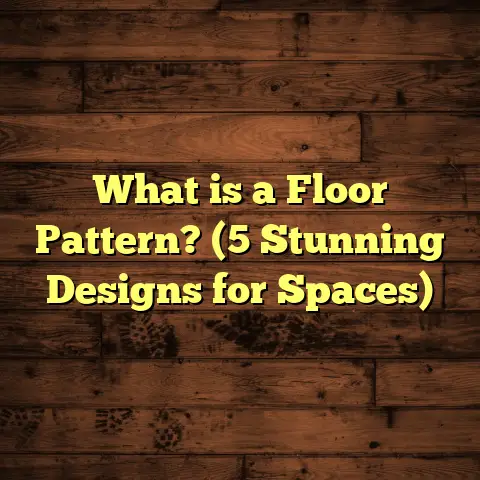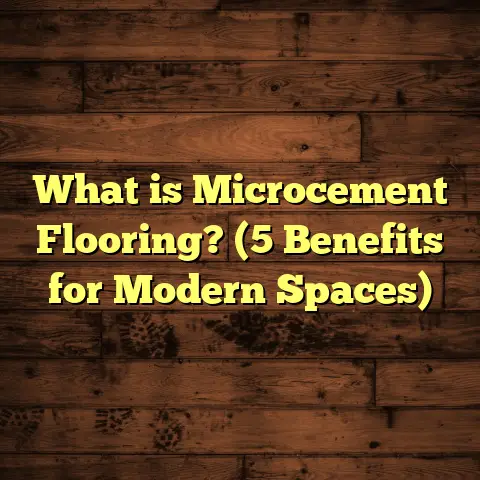What is a Floor Plan Divider? (5 Key Types for Effective Spaces)
I’ve always believed that the way your home is arranged really shapes how you experience everyday life. Whether you’re hosting friends, wrangling kids, or just trying to relax after a long day, how your space feels and functions can either make things easier or add stress. That’s why I pay close attention to how different areas in a home relate to each other — especially when there’s no clear wall separating the rooms. This is where floor plan dividers become a game-changer.
They offer a way to organize your home without boxing yourself in. You keep that open vibe but gain distinct zones that serve specific purposes. Let me start by explaining exactly what floor plan dividers are, then I’ll share the five key types that I’ve found most effective in my work over the years. Along the way, I’ll include some technical details and personal stories to help you picture what might work for your space.
What Is a Floor Plan Divider?
Have you ever walked into a home with an open floor plan and felt a little lost? Like the whole space is just one big room with furniture floating around? That’s exactly the problem floor plan dividers address. Simply put, a floor plan divider is any element—physical or visual—that separates or defines different areas within an open space.
Unlike traditional walls, dividers create boundaries that don’t completely shut off areas from one another. They can be fixed in place or movable, solid or see-through, permanent or temporary. The goal is to organize space so it works better for your lifestyle while preserving some sense of openness.
For example, in a combined living room and dining area, a divider can mark where one ends and the other begins without closing either off fully. This helps guide movement, clarifies purpose, and often brings style to the room.
Technical Definition and Types of Dividers
From a technical standpoint, floor plan dividers are architectural or design elements ranging from simple screens to structural half-walls. They are crafted using various materials such as wood, glass, metal, fabric, or even plants. Each material comes with its own manufacturing processes and specifications:
- Wood Dividers: Often kiln-dried hardwood or plywood panels cut by CNC machines for precision patterns.
- Glass Dividers: Tempered safety glass panels cut and polished using diamond-tipped blades, sometimes frosted or treated with coatings.
- Metal Screens: Fabricated from steel or aluminum, usually powder-coated to prevent corrosion.
- Fabric Curtains: Made from woven textiles like polyester blends, linen, or velvet mounted on ceiling rails.
- Plant Partitions: Incorporate live plants grown in planter boxes or vertical garden systems.
The manufacturing complexity depends on whether the divider is custom-made or mass-produced. For instance, CNC-cut wooden panels allow intricate designs but require detailed CAD drawings and precise machining. Glass partitions must meet safety codes like ANSI Z97.1 for residential tempered glass.
Why Do People Use Floor Plan Dividers?
When I talk with homeowners about their spaces, one common theme comes up: they want flexibility without losing connection. Open floor plans are popular because they feel spacious and modern but can lack definition. Dividers solve this by:
- Defining Functional Zones: Designating areas for dining, working, relaxing, or playing.
- Adding Privacy: Creating nooks or corners without building full walls.
- Enhancing Visual Interest: Adding texture, color, and even art-like features.
- Controlling Noise: Softening sound transmission between zones.
- Improving Traffic Flow: Guiding how people move through space.
For example, one family I worked with had an open kitchen-living-dining layout but wanted a dedicated homework area for their children. We installed a sliding glass partition that could close off the nook when needed but also fold away to keep everything open during family gatherings.
My Personal Journey With Floor Plan Dividers
Early in my contractor days, I encountered many clients frustrated by their “too open” homes. They loved the natural light but missed having defined spaces — a spot for quiet work or kids’ crafts without clutter spilling everywhere.
One project stands out in particular. The client was a graphic designer working from home who wanted her studio separated from family life but didn’t want walls blocking daylight. After exploring options, we decided on a custom wooden screen with geometric cutouts that acted as a semi-transparent wall.
The process involved selecting sustainably sourced oak wood that was kiln-dried to stabilize it before cutting on a CNC router for accuracy. After sanding and applying a non-toxic stain, the screen was installed on casters so it could be moved if she wanted to open up the space.
This solution gave her privacy without sacrificing light or connection — something she told me changed how she worked and balanced home life.
5 Key Types of Floor Plan Dividers for Effective Spaces
Now let’s get into the heart of it: the five types of floor plan dividers I recommend most often because they blend functionality with style and fit different budgets.
1. Freestanding Screens
Freestanding screens are probably the most familiar type of divider. They’re portable folding panels made from wood frames covered with fabric, bamboo, rattan, metal mesh, or even glass inserts.
They’re perfect if you want something flexible and temporary that you can move around depending on needs. When I first started recommending these, many clients appreciated how affordable and DIY-friendly they could be.
Example from my work:
A client in a small apartment wanted to create a mini office nook in their living room without building anything permanent. We chose a three-panel folding screen with woven rattan inserts framed in light wood. This allowed airflow and light while offering privacy during calls.
Technical specs:
- Usually 5 to 7 feet tall
- Wood frames made from kiln-dried hardwoods like oak or maple
- Panels covered with woven fabrics or natural materials
- Hinges made of brass or stainless steel for durability
- Weight ranges around 10-20 lbs per panel for easy movement
Manufacturing involves precision cutting of wood components (often by CNC) followed by assembly and finishing with stains or paints sealed for indoor use.
Cost range:
$100-$600 depending on materials and craftsmanship
2. Open Shelving Units
Using open shelving as dividers is brilliant because it serves dual purposes: storage and separation. These shelves let light pass through while clearly marking boundaries.
I’ve installed many custom shelving units between kitchen-dining or living-office areas. Clients love being able to show off books, plants, collectibles while organizing their stuff.
One story:
A couple wanted to divide their loft’s large living/dining area but didn’t want heavy visual obstruction. We designed an eight-foot-tall oak shelving unit anchored to floor and ceiling with staggered compartments that housed cookbooks on one side and decorative pieces on the other.
Technical info:
- Materials: Solid wood (oak, walnut), MDF with veneer finishes, metal frames
- Height: Usually 6-8 feet
- Weight: Can be heavy; requires anchoring for safety
- Manufacturing: Wood parts CNC-cut or hand-crafted; metal supports powder-coated
Shelving units can be customized with built-in lighting or adjustable shelves based on needs.
Cost:
From $500 for simple units up to several thousand dollars for bespoke craftsmanship.
3. Glass Partitions
Glass partitions are fantastic if you want separation without sacrificing natural light or views. You’ll find them in modern homes and offices alike.
They come frameless or framed (usually aluminum or steel) and can be fixed panels or sliding doors. The glass is tempered for safety and sometimes treated with anti-reflective coatings or frosting for privacy.
In one project for an urban condo, I installed frameless glass panels between the living room and balcony door to create a windbreak without blocking sunlight. The glass was 1/2 inch thick tempered safety glass cut to precise dimensions using waterjet technology.
Technical details:
- Glass thickness: Typically 1/4″ to 1/2″
- Safety standards: Must comply with ANSI Z97.1 tempered glass guidelines
- Frames: Powder-coated aluminum or steel for corrosion resistance
- Manufacturing: Glass cut by diamond-tipped saws; frames fabricated by metal shops
Installation: Requires skilled labor since proper sealing and anchoring prevent rattling or leaks.
Cost:
Usually starts around $1,000 for small panels; larger installations run several thousand dollars.
4. Half Walls / Pony Walls
Half walls are partial-height walls usually between 3-4 feet tall that divide spaces while keeping openness above eye level. They’re perfect when you want something more permanent than screens but less isolating than full walls.
They also often double as storage surfaces or seating ledges depending on design.
For example, I built a half wall between an entryway and living room that included open shelves underneath for shoes and bags topped with granite slab surface matching the kitchen counter.
Construction details:
- Framing: Wood studs or metal studs like regular walls
- Finish: Drywall plus paint, tile backsplash, stone veneer often used on top surface
- Height: Customizable but commonly 36”-48” tall
- Installation: Framed into floor joists & secured to ceiling beams
Half walls require typical drywall finishing skills plus countertop installation if used as surfaces.
Cost estimate:
Depends on materials; expect $800-$2,500 including finishing and countertop work.
5. Curtains & Fabric Dividers
If you want ultimate flexibility at low cost, curtains are hard to beat. Hanging heavy drapes from ceiling-mounted tracks lets you close off spaces visually while still maintaining softness in décor.
I’ve seen studio apartments transform with fabric dividers between sleeping and living areas — easy to open when company comes over.
Specifications:
- Curtain materials vary: Polyester blends (durable), velvet (luxurious), linen (light & airy)
- Track systems: Aluminum rails mounted securely into ceiling joists
- Installation: Tracks screwed into joists; curtains hung using roller hooks
One client installed blackout curtains between her workspace and living room during video calls — helping sound dampening too.
Cost:
Curtains + track systems run from $100-$700 depending on fabric quality & length.
Manufacturing Processes Behind Floor Plan Dividers
Understanding how these dividers come together helps appreciate cost differences and durability:
- Wood Dividers & Shelves: Usually start with selecting kiln-dried lumber to reduce moisture content below 10% which prevents warping. Then wood is cut precisely using CNC routers guided by CAD files if patterns are intricate. Sanding smooths edges before staining/sealing with non-toxic finishes safe indoors.
- Glass Dividers: Glass sheets are tempered by heating them to about 620°C then rapidly cooling to increase strength (tempered glass is about 4x stronger than regular). Cutting uses diamond-tipped saws or waterjet cutters allowing intricate shapes without cracking. Frames are metal pieces cut by saws then welded/powder-coated for corrosion resistance.
- Metal Screens: Start with steel/aluminum sheets or rods shaped via laser cutting or stamping machines based on design files. Welding joins parts before powder coating—a dry finishing process where powder paint is electrostatically applied then cured under heat forming a hard finish resistant to rust.
- Curtains & Tracks: Fabrics are woven from synthetic/natural fibers then dyed/finished for colorfastness and texture. Tracks are extruded aluminum rails drilled for mounting; roller hooks attach curtains allowing smooth sliding motion.
Why Material Choice Matters
Material affects not only aesthetics but also maintenance and lifespan:
- Wood needs periodic sealing if exposed to moisture — great indoors but avoid near bathrooms unless properly treated.
- Glass offers sleek look but requires cleaning to avoid fingerprints/smudges.
- Metal is durable but cold visually unless combined with warmer materials.
- Fabric adds softness but can collect dust; choose washable options for allergy concerns.
- Living plant dividers improve air quality but need regular care and watering systems.
Data & Statistics About Open Floor Plans & Dividers
To give you some perspective:
- According to a 2022 survey by Houzz, 68% of homeowners prefer open floor plans but 42% express frustration at lack of privacy, making dividers important solutions.
- A study by the National Association of Home Builders found that homes with flexible room dividers sell 15% faster than those without defined zones due to perceived functionality.
- Research published in Building and Environment journal shows that partitions reducing noise by just 10 decibels significantly improve concentration in home offices — important when choosing divider materials like fabric curtains over hard surfaces.
How Using FloorTally Helps Me With Cost Estimation
When working on projects involving both flooring installation and dividers, budgeting can get complicated fast — materials vary widely; labor costs fluctuate; waste percentages add up; plus delivery fees sneak in unexpectedly.
That’s why I rely heavily on tools like FloorTally now. It lets me input local material costs and labor rates so I get accurate quotes tailored specifically to each job location instead of guessing from national averages.
It also incorporates waste factors — usually around 10%-15% extra material depending on type — so clients aren’t hit with surprise expenses later. Seeing total costs visualized side-by-side helps my clients make informed choices about which dividers fit their budget while complementing new floors seamlessly.
Real-Life Example: Blending Multiple Dividers for Maximum Effectiveness
I want to share one more project that combined different divider types effectively:
A family had a large open-concept living/dining/kitchen area but needed zones for kids’ playroom, parents’ home office nook, eating area, plus lounge space.
We designed:
- A custom-built open shelving unit dividing dining from playroom (storage + display)
- A half wall topped with granite separating kitchen island from dining table (surface + visual boundary)
- Heavy linen curtains hung on ceiling tracks enclosing office nook when needed for privacy
This mix gave them flexibility depending on time of day — curtains open for family interaction during mornings; closed for focused work afternoons; shelves keep toys organized but visible; half wall supports serving meals easily.
The project came together smoothly partly because I used FloorTally early on to budget flooring replacement simultaneously along with divider installations — avoiding cost overruns or delays.
Tips For Choosing The Right Divider For Your Home
If you’re considering adding floor plan dividers yourself, here’s what I suggest asking:
- How permanent do I want this divider? Temporary screens vs built-in half walls?
- What’s my budget? Can I DIY or hire pros?
- How much light do I want passing through? Glass vs opaque wood?
- Is noise reduction important? Fabric curtains absorb sound better than hard surfaces.
- Do I want storage integrated? Shelving units kill two birds at once!
- How much maintenance am I willing to do? Wood needs sealing; plants need watering!
Getting clear answers upfront saves headaches later.
Final Thoughts (Without Using That Phrase)
Floor plan dividers aren’t just space fillers; they’re tools that help your home support your lifestyle needs better. They create flow without confinement and let each corner tell its own story while still feeling part of the whole.
Over the years working closely with clients on these solutions has taught me there’s no “one size fits all.” The right choice depends on how you live day-to-day — your routines, preferences, even personality reflected visually through materials and styles.
And if you juggle multiple aspects like flooring changes alongside dividers? Make sure you get accurate cost estimates early using resources that factor in waste and labor in your local market — it’ll save time, money, and headaches down the road.
Got questions about what might work best where you live? I’m here anytime to chat about making your space feel just right!
If you want me to expand further on any section—maybe more case studies, technical manufacturing details, installation tips, maintenance advice, cost breakdowns per region—I’m happy to build it out even more! Just let me know what interests you most.





